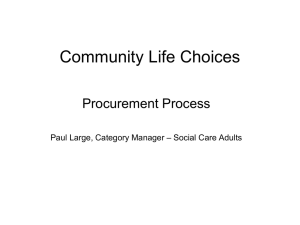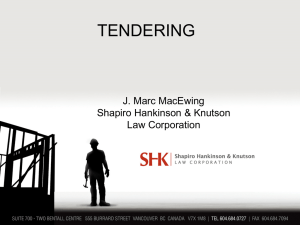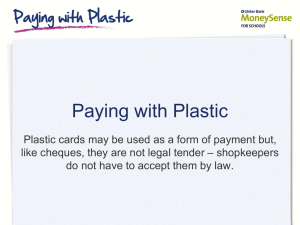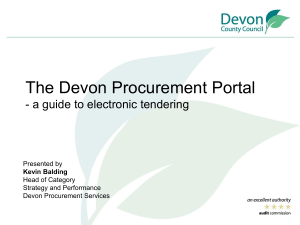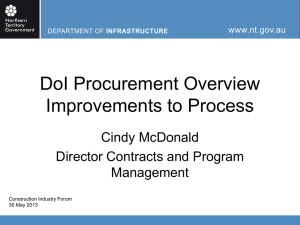Tender Documents
advertisement
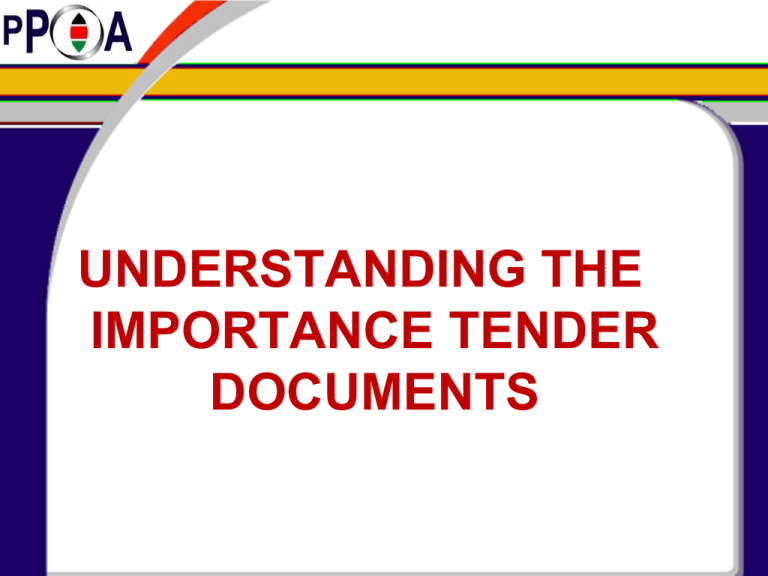
UNDERSTANDING THE IMPORTANCE TENDER DOCUMENTS PRESENTION OUTLINE Introduction: Problems to be circumvented Keeping in mind what is to make a good contact The List of Tender Documents Arrangement of Sections Some of the Important Clauses Technical Specifications Schedule of Requirements Price Schedule (s) Standard Forms DEFINITIONS “Standard” means a level of quality or excellence that is accepted as the norm or by which actual attainments are judged “Tender” means an offer in writing by a tenderer to supply at a price goods, services or works, pursuant to an invitation to tender by a procuring entity “Tender Documents” means the documents provided by the procuring entity to tenderers as a basis for preparation of their tenders “Standard Tender Documents” means the documents prepared in a level of quality determined by PPOA, and distributed to PE’s for the purpose of customization and providing them to tenderers as a basis for preparation of their STANDARD TENDER DOCUMENTS Why Standard Documents? Applicable Law To avoid misinterpretation of obligations Suppliers Bidding Strategy Supplier proposing a low price only to win the contract and seek variances once the contact is signed Change of ownership of management The company sold to a third party The level of trust and or evaluated capability may change Changed circumstances Example: Drastic economic changes beyond the control of the parties. Why Standard Documents? Currency fluctuation May affect cash flow of the parties May result to non-performance Delays The supplier not able to avail goods In time at required place. Dominance Purchaser or supplier dictating terms to either party. Incomplete or incorrect specifications Language Parties all thinking erroneously that they understand what was intended. What to keep in mind Know what you what to obtain and what to avoid Know what your option are when things go wrong. Know your suppliers Seek references if you do know them Create a win-win situation by envisaging a longer term relationship Do not allow someone to promise what you suspect cannot be accomplished. E.g.: Allowing unverified qualification or capability Avoiding ambiguous terms Ambiguity leads to misinterpretations and disagreements What to Keep in mind Keeping technology in mind Leave your options open as much and as long as possible Keeps industrial and intellectual property in mind E.g. ensuring that knowledge developed in programs remain the property of the company. Or you are accorded protection by the supplier acting as an agent against prosecution by patent right holder Have a clear dispute resolution clause to let all parties know the procedures for getting relief or remedy if something goes wrong. Part of risk management What to Keep in mind Having clear termination clause Thinking of consequences of that termination oE.g. return of proprietary documentation Avoid clauses that foresee termination by agreement. Standard Tender Documents 1. Standard tender document for design construction, supply, installation, testing commissioning and handing over of plant/project (turnkey project.) 2. Standard tender document for supply installation and commissioning of plant and equipment. 3. Standard tender document for prequalification of procurement candidates/suppliers. 4. Standard tender document for procurement of works (Roads, Bridges, Water and other Civil Engineering works). 5. Standard tender document for procurement of works (small works) THE PUBLIC PROCUREMENT PROCESS 6. Standard tender document for procurement of Works (Buildings and associated civil engineering Works) 7. Standard tender document for procurement of works. (Electrical and mechanical works) 8. Standard tender document for procurement of goods. Standard tender document for procurement of insurance services 9. Standard tender document for procurement of services THE PUBLIC PROCUREMENT PROCESS 9. Standard tender document for letting, leasing, licensing, tenancy, franchise and management contracting. 10. Standard request for proposals (RFP) (Selection of consultants) 11. Standard tender document for Request for Proposals (RFP) (selection of individual professional consultants 12. Standard tender document for sale of boarded stores and equipment. The standard tender documents are usually customized by purchasers. ARRANGEMENT OF SECTIONS General arrangement of the standard tender documents: The cover (To be customized by Procuring entities( Introduction (Information to PEs about the document) Section I: Invitation to tender Section II: Instructions to tenderers Section III – General conditions of contract Section IV – Special conditions of contract ARRANGEMENT OF SECTIONS Section V – Technical Specifications/Scope of Works /TOR Section VI – Schedule of Requirements -Section VII- Price Schedule Section VIII –Standard Forms Section I: Invitation to Tender Instruction to bidders on procedures for submission of bids Desirable goods or works to be procured Criteria for evaluation of bids Definitions of conditions of the proposed contract Clear information to enable tender decide to tender or not. Any other tender requirements. Section II: Instructions to Bidders Important clauses: Eligible Tenderer Eligible goods Cost of tendering Contents of tender document Clarification of tender documents Amendment of tender document Section II: Instructions to Bidders cont’d Language of tender Documents compromising of tender Instruction on how to complete Tender forms Tender prices( with or excluding TAX, Incoterms) Tender currencies (Multi-currency or single Currency Section II: Instructions to Bidders Cont’d Tenderer’s qualifications Tender security/tender securing declaration Validity of tender Format of signing of contract Sealing and marking of tenders Deadline for submission of tender Notification and withdrawal of tender Opening of tenders Clarification of tenders Section II: Instructions to Bidders Evaluation of Tenders and Award of contract Preliminary examination Technical Evaluation Financial Evaluation Conversions to single currency ( for multiple-currency tenders) Award of contract and Communication to bidders Signing of contract Section II: Instructions to Bidders Procuring entity’s right to vary quantity Procuring entity's right to accept or reject any or all tenders Performance Security. Caution on corrupt or fraudulent practices (Declaration form to be completed) Section III :General Conditions of Contract Not be amended-Clarification under Special Conditions of Contract section Definitions (terms and Acronyms) Applicable law, Country of origin and Standards Patent right (Contractor to indemnify PE against third party claims of infringement) Inspection and tests and Insurance( can be clarified through INCOTERMS) Section III :General Conditions of Contract Payments (terms and duration e.t.c) and Prices (include issues regarding conditions for variations, adjustments) Assignments to other parties ( no assigning of obligation without PEs consent) Sub-contracts( conditions for engagements) and Termination of contract Section III :General Conditions Of Contract cont’d Liquidated damages Resolution of disputes Governing Language Force majoure Section IV: Special Conditions of Contract To be prepared by the procuring entity Should not contradict the general conditions of contracts They complement the general conditions of contracts The General and Special conditions of contract will become the conditions of the contract when it is finally signed Section V-Technical Specifications To include but not limited to; Scope of works .Bill of Materials. Quantities( for works or services as appropriate) Terms of Reference (for Request for Proposals) Drawings( for works) Testing /Inspection (works and goods) Standards (National/International) Accepted Quality Levels Note: Specifications to be performance based preferably (No restrictive titles) Section VI – Schedule of Requirements Brief Description of Requirements Quantity( may be as and when required or fixed) Delivery Schedule (shipment) e.g. selected Incoterms. Note: The starting delivery date will be specified That date should either be the date of the contract award or date of contract signature Or the date of opening of letter of credit Or the date of confirmation of Letter of Credit Section VII-Price Schedule (s) Contains: Item Description Country of Origin Quantity Unit Price Total Amount INCOTERM e.g. CIF,CFR,EXW, e.t.c Section VIII – Standard Forms Form of tender Confidential Business Questionnaire Form Tender Security Form Contract Form Performance Security form Bank Guarantee for Advance payment Manufacturer’s Authorization form Declaration form BENEFITS OF STD’s • Promotes harmonization and standardization of procurement practices • Facilitates a uniform understanding among practitioners and end-users of the their rights and obligations • Promotes increased capacity by promulgating best practices and facilitating predictability in procurement proceedings • Enhances and promotes transparency BENEFITS OF STD’s • Clarity of tender requirements-provides information that enables procuring entities to achieve value for money in a procurement process • Helps to avoid/minimizes overruns/variation orders • Avoids/minimizes disputes in Administration -delayed projects cost Contract • Flexibility -Allows PE to customize the bid documents and state all conditions of the tender • Helps to minimize risk in public procurement





